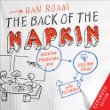|
|
RoaBack 10-01-018 |
|
|
The Back of the
Napkin Solving
Problems and Selling Ideas with Pictures Dan
Roam Penguin
Books, 2009, 281 pp. ISBN 978-1-59184-306-1 |
|
Dan Roam is the president of Digital Roam
Inc. He has helped major corporations
solve complex problems through visual thinking. This is a two-color book showing – with many
simple pictographs – how to develop and illustrate your ideas by using simple
pictures. He presents a fresh way of
looking at problems and seeing solutions.
And you don’t have to be able to draw!
However, even though the
drawings are simple, the book is complex. “Any problem can be made clearer with a picture,
and any picture can be created using the same set of tools and rules.”
(12) Immediately you think: What
problems? What pictures? And Who? He
sorts problems into six categories: who
and what, how much, when, where, how, and why
problems. “The basics of visual thinking have nothing to do
with creating charts on a computer.
Visual thinking is learning to think with our eyes, and it doesn’t
require any advanced technology at all.” (19)
Everything you need to draw can be categorized as
basic shapes, lines and arrows, and people and things. ”The spontaneity and
roughness of hand-drawn pictures make them less intimidating and more
inviting….” “In the end, visual
thinking isn’t about how polished our presentations are, it is about how
comfortable we are in thinking with our eyes.” (23) Visual thinking is something that we
already know how to do! Visual thinking is a four-step process that uses
three built-in tools (our eyes, our mind’s eye, and our hand-eye
coordination), and six ways of seeing.
Imagine a poker hand. First we look at the cards. Then we
see them – the color, number, suit,
etc. Then we imagine how the patterns fit together as a hand. These are the three ways of seeing. We look,
then see, then imagine. And then we show with a picture. (35) Looking = Collecting and screening. Seeing = Selecting and clumping (recognizing
patterns) Imagining = Seeing what isn’t there, meaning Showing = Making it clear. Being able to draw well comes from being able to look well. The starting point isn’t
learning to draw better but learning to look better. (45-6) Rule 1.
Collecting everything possible at the beginning. Rule 2.
Lay it all out where you can look at it. Rule 3.
Establish the underlying information coordinates (how it fits in
space) There
are 6 coordinates: Who/what, How much, Where, When, How, Why These
work for almost every thing and every idea. Rule 4.
Practice visual triage. Utilize
your experiential intuition that makes instant judgments about what is
important to look at and what is not.
Our minds are great at intuitive judgments about what to notice. “While looking
is about collecting the raw visual information that is in front of us, seeing is about selecting what’s
important.” (67) “Seeing is selecting
and identifying patterns. And really
good seeing is … problem recognition.” (68) As things happen, our eyes see who/what and how many. They also see where and when. They often combine these things and deduce how.
And we begin to make rational arguments about why things happened. This is an intuitive problem-solving
approach. (77-79) We apply our imagination when, after seeing what is there, we close our eyes and let
our mind’s eye take over and see what is not physically there. “The real goal of visual thinking is to make the
complex understandable by making it visible.” (105) Well, it’s a long and complex book, made
understandable by all the pictures.
But you get the idea. |
|
*
* * * * *
Your comments and book
recommendations are welcome.
To discontinue receiving
book notes, hit Reply and put Discontinue in the text.
